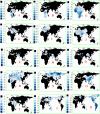Y chromosome diversity, human expansion, drift, and cultural evolution
- PMID: 19920170
- PMCID: PMC2787129
- DOI: 10.1073/pnas.0910803106
Y chromosome diversity, human expansion, drift, and cultural evolution
Erratum in
- Proc Natl Acad Sci U S A. 2010 Jul 27;107(30):13556
Abstract
The relative importance of the roles of adaptation and chance in determining genetic diversity and evolution has received attention in the last 50 years, but our understanding is still incomplete. All statements about the relative effects of evolutionary factors, especially drift, need confirmation by strong demographic observations, some of which are easier to obtain in a species like ours. Earlier quantitative studies on a variety of data have shown that the amount of genetic differentiation in living human populations indicates that the role of positive (or directional) selection is modest. We observe geographic peculiarities with some Y chromosome mutants, most probably due to a drift-related phenomenon called the surfing effect. We also compare the overall genetic diversity in Y chromosome DNA data with that of other chromosomes and their expectations under drift and natural selection, as well as the rate of fall of diversity within populations known as the serial founder effect during the recent "Out of Africa" expansion of modern humans to the whole world. All these observations are difficult to explain without accepting a major relative role for drift in the course of human expansions. The increasing role of human creativity and the fast diffusion of inventions seem to have favored cultural solutions for many of the problems encountered in the expansion. We suggest that cultural evolution has been subrogating biologic evolution in providing natural selection advantages and reducing our dependence on genetic mutations, especially in the last phase of transition from food collection to food production.
Conflict of interest statement
The authors declare no conflict of interest.
Figures


Similar articles
-
Founders, drift, and infidelity: the relationship between Y chromosome diversity and patrilineal surnames.Mol Biol Evol. 2009 May;26(5):1093-102. doi: 10.1093/molbev/msp022. Epub 2009 Feb 9. Mol Biol Evol. 2009. PMID: 19204044 Free PMC article.
-
Clinal patterns of human Y chromosomal diversity in continental Italy and Greece are dominated by drift and founder effects.Mol Phylogenet Evol. 2003 Sep;28(3):387-95. doi: 10.1016/s1055-7903(03)00016-2. Mol Phylogenet Evol. 2003. PMID: 12927125
-
Natural selection reduced diversity on human y chromosomes.PLoS Genet. 2014 Jan;10(1):e1004064. doi: 10.1371/journal.pgen.1004064. Epub 2014 Jan 9. PLoS Genet. 2014. PMID: 24415951 Free PMC article.
-
The impact of recent events on human genetic diversity.Philos Trans R Soc Lond B Biol Sci. 2012 Mar 19;367(1590):793-9. doi: 10.1098/rstb.2011.0297. Philos Trans R Soc Lond B Biol Sci. 2012. PMID: 22312046 Free PMC article. Review.
-
The reality and importance of founder speciation in evolution.Bioessays. 2008 May;30(5):470-9. doi: 10.1002/bies.20745. Bioessays. 2008. PMID: 18404703 Review.
Cited by
-
Molecular dissection of the basal clades in the human Y chromosome phylogenetic tree.PLoS One. 2012;7(11):e49170. doi: 10.1371/journal.pone.0049170. Epub 2012 Nov 7. PLoS One. 2012. PMID: 23145109 Free PMC article.
-
New Y-SNPs in QM3 indigenous populations of Colombia.PLoS One. 2023 Dec 6;18(12):e0294516. doi: 10.1371/journal.pone.0294516. eCollection 2023. PLoS One. 2023. PMID: 38055663 Free PMC article.
-
Low historical rates of cuckoldry in a Western European human population traced by Y-chromosome and genealogical data.Proc Biol Sci. 2013 Dec 7;280(1772):20132400. doi: 10.1098/rspb.2013.2400. Proc Biol Sci. 2013. PMID: 24266034 Free PMC article.
-
The Origin and Composition of Korean Ethnicity Analyzed by Ancient and Present-Day Genome Sequences.Genome Biol Evol. 2020 May 1;12(5):553-565. doi: 10.1093/gbe/evaa062. Genome Biol Evol. 2020. PMID: 32219389 Free PMC article.
-
AMY-tree: an algorithm to use whole genome SNP calling for Y chromosomal phylogenetic applications.BMC Genomics. 2013 Feb 13;14:101. doi: 10.1186/1471-2164-14-101. BMC Genomics. 2013. PMID: 23405914 Free PMC article.
References
-
- Hagedoorn AL, Hagedoon AC. The Relative Value of the Processes Causing Evolution. The Hague: Martinus Nijho; 1921.
-
- Fisher RA. On the dominance ratio. Proc R Soc Edinburgh. 1922;42:321–341.
-
- Wright S. Evolution and the Genetics of Populations. Volume 2: The Theory of Gene Frequencies. London: University of Chicago Press; 1969.
-
- Kimura M. Evolutionary rate at the molecular level. Nature. 1968;217:624–626. - PubMed
-
- Le Cam LM, Neyman J, editors. Proceedings of the Fifth Berkeley Symposium on Mathematical Statistics and Probability, Volume 4: Biology and Problems of Health Conference; Berkeley: University of California Press; 1966.
Publication types
MeSH terms
LinkOut - more resources
Full Text Sources
Molecular Biology Databases

